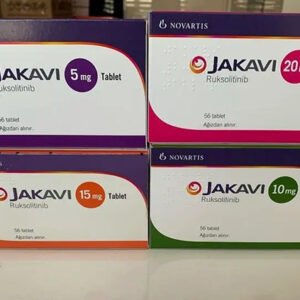Ruxolitinib Phosphate Tablets.
Function and indication:
It is suitable for adult patients with moderate or high-risk primary myelofibrosis (PMF) (also known as chronic idiopathic myelofibrosis), myelofibrosis secondary to polycythemia vera (PPV-MF) or myelofibrosis secondary to essential thrombocythemia (PET-MF), to treat splenomegaly or disease-related symptoms related to related diseases.
Usage and Dosage:
1. Only doctors with experience in the use of anti-tumor drugs can use this product for treatment. 2. Before starting treatment with this product, a complete blood count, including a white blood cell differential count, must be performed. 3. When using this product for the first time, a complete blood count should be monitored weekly, including white blood cell, platelet and red blood cell differential counts. After 4 weeks, the complete blood count can be monitored every 2-4 weeks until the dose of this product is stable, and then it can be monitored according to clinical needs (see [Precautions]). 4. Dosage (1) Starting dose For patients with platelet counts between 100,000/mm3 and 200,000/mm3, the recommended starting dose of this product is 15 mg twice a day. For platelet counts. For patients with platelet counts >200,000/mm3, the recommended starting dose is 20 mg twice a day. For patients with platelet counts between 50,000/mm3 and <100,000/mm3, the recommended maximum starting dose is 5 mg twice a day. Currently, there is limited research data on 5 mg twice a day, and the efficacy of long-term maintenance administration of 5 mg twice a day is uncertain. Long-term use at this dose should be limited to patients who are judged to have benefits that outweigh potential risks and the drug dose should be adjusted with caution. (2) Dose adjustment Dose adjustment guidelines for hematological toxicity in patients with myelofibrosis who have a platelet count of 100 × 109/L or higher at the start of treatment Treatment interruption and re-administration When the platelet count is less than 50 × 109/L or the absolute neutrophil count (ANC) is less than 0.5 × 109/L, interrupt treatment. When the platelet count recovers to above 50 × 109/L and the ANC recovers to above 0.75 × 109/L, the drug can be re-administered. (See instructions for details) 5. Special populations (1) Patients with renal impairment ① For patients with mild or moderate renal impairment, no additional dose adjustment is required. ② If the patient has severe renal impairment (creatinine clearance less than 30 ml/min), the recommended starting dose should be reduced by approximately 50% based on the platelet count and administered twice a day. During treatment with this product, patients should be closely monitored for safety and efficacy. ③ There is limited data on how to determine the best dosing regimen for patients with end-stage renal disease (ESRD) who are receiving hemodialysis. Pharmacokinetic/pharmacodynamic simulations based on existing data in this population indicate that for patients with ESRD who are receiving hemodialysis, the starting dose is a single dose of 15 mg-20 mg, which is administered only after the completion of hemodialysis on the day. If the patient’s platelet count is between 100,000/mm3 and 200,000/mm3, the single dose is 15 mg. If the patient’s platelet count is >200,000/mm3, the recommended single dose is 20 mg or 10 mg every 12 hours (2 doses in total) . Subsequent dosing (single dose or 10 mg every 12 hours for a total of 2 doses) is administered on the same day of blood collection during each dialysis cycle, once a day. The recommended dose is based on numerical simulations, and for ESRD patients, any dose adjustment should be made only after close monitoring of individual safety and efficacy. There is a lack of data on dosing regimens for patients on peritoneal dialysis or continuous veno-venous hemodialysis (see [Pharmacokinetics]). (2) Patients with hepatic impairment If the patient has mild, moderate, or severe liver impairment (corresponding to Child-Pugh grades A, B, and C), the recommended starting dose should be reduced by approximately 50% based on the platelet count and administered twice a day. Based on close monitoring of safety and efficacy, the recommended dose should be reduced by approximately 50% based on the platelet count and administered twice a day. The subsequent dosage should be adjusted. In the case of liver damage, a complete blood count should be monitored during treatment with this product, including white blood cell counts and counts. This should be monitored at least once every one to two weeks within the first 6 weeks after starting treatment with this product. If the patient’s liver function and blood cell counts are stable, subsequent monitoring can be based on clinical conditions. In order to reduce the risk of cytopenia, the dosage of this product can be adjusted. 6. Dosage (1) This product is administered orally and can be taken with or without food. (2) If a dose of medication is missed, the patient should not make up for the missed dose, but should take the next dose on time according to the original dosing schedule.
Adverse reactions:
1. Myelofibrosis: The most commonly reported adverse reaction is thrombocytopenia. 1. The three most common non-hematological adverse reactions were contusion (21.6%), dizziness (15.3%), and headache (14.0%). 2. The three most common non-hematological laboratory abnormalities were elevated alanine aminotransferase (27.2%), elevated aspartate aminotransferase (18.6%), and hypercholesterolemia (16.9%).
Contraindications:
1. Allergy to the active ingredient or any excipient. 2. Pregnancy and lactation
Share:
Products
Our offers
Health Classification
Let us work together to protect precious health
































